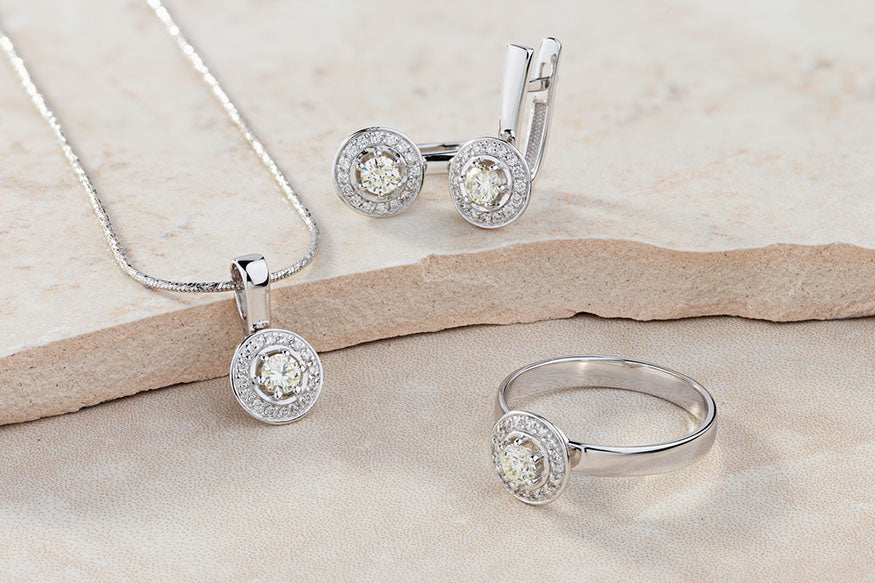Does White Gold Tarnish?
If you follow celebrity jewelry trends, you may have noticed white gold chains, earrings, rings, and bracelets are transforming looks everywhere from the runways to the music industry. Whether it’s a look-at-me iced out statement piece or a glam up my t-shirt and jeans look, white gold is definitely turning heads.
White gold is widely used for intricate designs and jewelry expected to withstand significant wear, such as a timeless locket or pendant. While it is built for durability, white gold can still tarnish over time when exposed to certain chemicals, excess friction, and body oils.

Source: TorriPhoto/Shutterstock.com
What is White Gold?
White gold is a gold alloy plated with rhodium. The alloy is made of 8, 14, or 18 karat (K) gold and either nickel, silver, or palladium. Gold alloys with these additional metals create a less intense yellow coloration. Gold alloys are not intensely bright white, so they need rhodium plating to complete the eye-catching look.
Rhodium is a noble metal in the platinum family with a white and silver appearance. There are no rhodium mines, and the metal is only produced as a byproduct of platinum and nickel mining. Its rarity results in a price tag of nearly $12,000 per ounce.
Despite rhodium’s rarity and cost, jewelers use it for almost all white gold jewelry. They use minuscule amounts of rhodium, usually .75 microns worth, to coat gold alloys. Rhodium is corrosion resistant, has radiant color and shine, and is relatively wear-resistant. It is used for gold chains, wedding bands, engagement rings, earrings, chains, and even collar clips for a fun detail to add to your shirts or blazers.
SHOP FOR WHITE GOLD CHAINS AT Daniel Jewelry NY
Source: Jan Dix/Shutterstock.com
What Causes White Gold to Tarnish?
While rhodium is wear-resistant, it can still tarnish over time. When jewelry tarnishes, it fades, or its color changes due to oxidation. However, white gold jewelry doesn’t actually tarnish; it simply reverts to its original gold alloy color when the rhodium coating thins and the gold alloy is exposed. A sign that white gold jewelry is tarnished is a slightly yellow or brown appearance. Excessive chlorine exposure, friction, and body oils can all tarnish white gold.
- Chlorine
Chlorine, the active sanitizing chemical in pools and some cleaning products, is highly corrosive. When gold alloys are exposed to chlorine, the non-gold metals, like nickel and silver, break down and leave small bubbles in the jewelry. This changes the gold alloy’s color and makes it prone to damage.
Rhodium is not as significantly affected, but chlorine does wear down the thin rhodium plating, making the jewelry transparent. This changes the color of white gold jewelry, and if the rhodium wears completely away, the gold alloy is exposed.
Chlorine can then do lasting damage to the structure and color of white gold jewelry. Removing all jewelry, including white gold jewelry, is advisable before entering a swimming pool or using cleaning products.
- Friction
Friction is a mechanical process that wears down rhodium plating over time. Common daily activities that result in friction on jewelry include washing hands and driving. Friction wear is most commonly found on rings because hands are constantly in contact with other items.
All rings, from an engagement ring to a men’s gold pinky ring, should be consistently inspected for signs of wear. The shank, or bottom of the ring, is the most common location for white gold dulling because it touches anything a person holds, like a steering wheel.

Source: Art_girl/Shutterstock.com
- Bodily minerals and oils
Our skin is home to numerous oils and minerals that keep it healthy. Unfortunately, those same substances can slowly degrade rhodium coating. Sweat specifically causes metals to be released from gold alloy jewelry because of low pH levels and salt’s degrading effects. If your white gold jewelry goes long periods without a clean, body oils build up and degrade the rhodium coating.
Fixes and Preventative Care
If your white gold jewelry appears yellow or brown in spots, then it is time to get it recoated. The average rhodium coating lasts about 12-18 months before it needs another coat to maintain its shiny appearance. Jewelers can quickly replate white gold jewelry in one visit.
To preserve white gold jewelry, it is important to remove it when you sleep to limit body oil build-up, keep it away from harsh chemicals like chlorine, and clean it regularly. You should clean a white 14k gold chain every couple of months or more if you wear it frequently. The more you wear white gold jewelry, the more it needs to be cleaned if you want it to shine like new.
BROWSE OUR COLLECTION OF 14K GOLD CHAINSAdd White Gold to Your Jewelry Collection
White gold is extremely popular due to its luxurious appearance and corrosion-resistant exterior. It is a durable choice for engagement rings, chains, and any contemporary jewelry that you want to make a statement. However, white gold still needs to be properly cared for to maintain its luster.
Visit Daniel Jewelry NY for a wide variety of jewelry, ranging from white gold chains to bracelets, watches, and rings. Our expansive inventory is filled with current styles to offer you the latest jewelry fashion.

